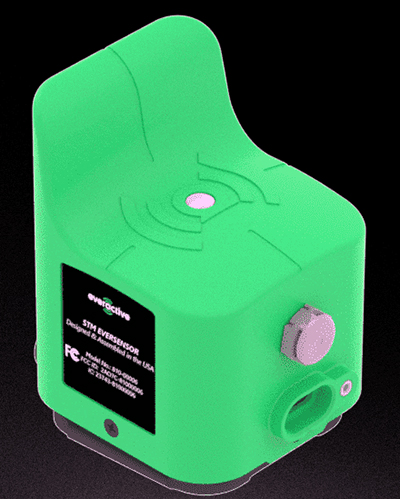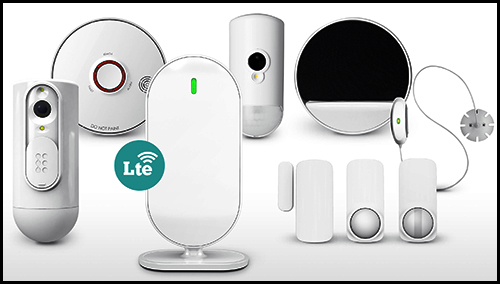Presented here are recent news announcements regarding the following organizations: Everactive, Software AG, MachNation, Semtech, EchoStar Mobile, Avnet, Omdia, Ambiq and Essence Group.
Everactive Intros IoT Steam-Trap Predictive-Maintenance Solution
Everactive, which sells wireless Internet of Things (IoT) solutions, has announced a new generation of its Steam Trap Monitoring (STM) system designed to deliver predictive maintenance for large-scale steam-system applications. The batteryless IoT solution for steam traps involves devices known as Eversensors, which connect to an IoT gateway via the company’s Evernet 2.0 wireless network. Everactive’s customers include Colgate-Palmolive, Hershey’s, Merck, Mars, Morgan Stanley, the National Institutes of Health and the United States Air Force.
 Utilizing ultra-low-power electronics, the system is intended to let users continuously and indefinitely power Eversensors from harvested energy, eliminating the need for batteries while enabling the monitoring of industrial assets at scale. The latest generation of the technology offers wireless non-line-of-sight communication up to a distance of 250 meters (820 feet), the company reports, providing coverage of a higher percentage of steam traps with fewer gateways required throughout a facility. Everactive has increased the capacity of its IoT gateways to 1,000 Eversensors.
Utilizing ultra-low-power electronics, the system is intended to let users continuously and indefinitely power Eversensors from harvested energy, eliminating the need for batteries while enabling the monitoring of industrial assets at scale. The latest generation of the technology offers wireless non-line-of-sight communication up to a distance of 250 meters (820 feet), the company reports, providing coverage of a higher percentage of steam traps with fewer gateways required throughout a facility. Everactive has increased the capacity of its IoT gateways to 1,000 Eversensors.
The system has a small footprint, according to Everactive, and its architecture is designed to speed up the installation process with an integrated and sleeker mechanical design, as well facilitate provisioning with an auto-pairing feature and QR code provisioning. A single STM Eversensor can be installed on a steam trap and be set up in the cloud in less than five minutes, the company claims. The STM solution targets steam traps used in critical process manufacturing, oil and gas, and district energy-heating applications. Operations and maintenance personnel can address failures as they occur and achieve energy and carbon dioxide savings.
“Our current steam trap monitoring solution is a unique product in the market, and we are experiencing explosive growth,” said Keal Harter, Everactive’s director of product management, in a prepared statement. “With the adoption of steam trap monitoring sensors rapidly expanding, we’ve upgraded the STM product to our second-generation platform to better serve the market’s needs. I’m really excited about the potential this unlocks to accelerate adoption and scale implementations at existing and new customers.”
Software AG Uses MachNation IoT Performance-Testing System
Software AG has selected the MachNation IoT Test Environment Performance (MIT-E Pf) software suite to conduct testing and tuning of Cumulocity IoT, its low-code, self-service platform for connected solutions. MIT-E Pf will be used to independently verify the performance and reliability of IoT solutions created on Cumulocity IoT. The relationship builds on a longstanding partnership between the two companies, which includes IoT capability and usability benchmarking in MachNation’s IoT platform test lab, as well as strategic and business support.
“Software AG is delighted to provide its customers with highly reliable and resilient connected solutions,” said Jürgen Krämer, Software AG’s general manager for IoT and analytics, in a prepared statement. “IoT performance testing is one way we ensure the quality of our software. We chose MachNation MIT-E Pf because of its innovative technology and ability to do high-scale testing, along with the deep IoT knowledge of MachNation’s testing team.”
MIT-E Pf is an independent, hands-on benchmarking lab for Internet of Things platforms. According to MachNation, the solution is designed to test and validate the performance and scalability of IoT platforms and solutions for enterprises, service providers and IoT platform vendors. Built using a serverless, infrastructure-as-code architecture, the system allows users to simulate realistic, bidirectional IoT devices at scale, and to provide highly granular output metrics, the company reports.
“We are proud to have partnered with Software AG for many years,” added Steve Hilton, MachNation’s president, in the prepared statement, “and to have earned the opportunity to provide Software AG with some of the newest performance-testing technology and services for IoT. Using MIT-E Pf, we work with our customers to test and tune their IoT platforms and end-to-end customer solutions. This allows them to offer exceptional IoT solutions to their customers.”
Semtech, EchoStar Mobile to Test Satellite IoT Connectivity Integrated With LoRaWAN
Semtech and EchoStar Mobile have announced the launch of an initiative to test satellite connectivity services enabled by the LoRaWAN protocol. Semtech supplies analog and mixed-signal semiconductors and algorithms, while EchoStar Mobile provides mobile satellite services offering connectivity throughout Europe via a converged satellite and terrestrial network. EchoStar Mobile recently joined the LoRa Alliance.
 “With our technology collaborator, Semtech, and as a new member of the LoRa Alliance, we are excited to explore the use of next-generation LoRaWAN network technology to bring new satellite-based connectivity services to the Internet of Things market,” said Telemaco Melia, EchoStar Mobile’s senior director of commercial operations, in a prepared statement. “New LoRa satellite services are expected to bring lower price points to the market, opening up a larger addressable opportunity across key industries, including logistics, asset tracking, transportation, utilities, agriculture and maritime.”
“With our technology collaborator, Semtech, and as a new member of the LoRa Alliance, we are excited to explore the use of next-generation LoRaWAN network technology to bring new satellite-based connectivity services to the Internet of Things market,” said Telemaco Melia, EchoStar Mobile’s senior director of commercial operations, in a prepared statement. “New LoRa satellite services are expected to bring lower price points to the market, opening up a larger addressable opportunity across key industries, including logistics, asset tracking, transportation, utilities, agriculture and maritime.”
The use of Long Range Frequency Hopping Spread Spectrum (LR-FHSS) extends the LoRaWAN protocol’s support to enable direct data links from end nodes to satellites, the companies report, by leveraging either the Industrial, Scientific and Medical (ISM) unlicensed band or, in the case of EchoStar Mobile, through licensed spectrum, thus providing a differentiated service versus the ISM band. LR-FHSS can support millions of end nodes, the companies explain, and provide robustness for IoT services.
“It’s estimated that only 10 percent of the world’s surface has terrestrial connectivity,” added Marc Pegulu, the VP of IoT product marketing and strategy in Semtech’s Wireless and Sensing Products Group, in the prepared statement. “Semtech’s LoRa devices, integrated with LR-FHSS, allow satellites to connect IoT devices in the vast remote areas around the globe to enable IoT solutions with an unmatched continuum of coverage and performance. Our work with EchoStar Mobile and LoRa Alliance members is expected to achieve complementary satellite and terrestrial LoRaWAN network connectivity services for customers who require global coverage from land to sea to air.”
Avnet Offers IoT Proof-of-Concept Development Platform
Avnet has announced that its Avnet Express Connect tool enables developers and non-programmers to deploy combinations of connected IoT solutions at the edge, while linking this data to cloud dashboards and software-as-a-service (SaaS) applications. This, the company reports, expands Avnet’s IoTConnect platform, which is designed to accelerate time-to-market and reduce costs for IoT developers and customers.
“Avnet is addressing the most significant problems customers face when considering IoT projects: complexity, scalability, security and high deployment costs,” said Lou Lutostanski, Avnet’s VP of IoT, in a prepared statement. “By enabling a low code-no code drag-and-drop connection from an initial library of over 400 preconnected sensors and devices, Avnet Express Connect significantly reduces hardware proof-of-concept development from weeks to hours without the need for programmers.”
Avnet’s new tool enables the creation and evaluation of IoT-based designs. It contains a library of industrial IoT sensors, interface boards and gateways that can be linked in combinations via a drag-and-drop design environment. Once a design is created, the platform generates all underlying code, which is remotely deployed to any Avnet Express Connect gateway within seconds. Avnet Express Connect supports sensors ranging from those measuring temperature and humidity levels to more specialized devices. Suppliers supported include Omega, TE, Amphenol, Advantech and more, the company indicates, with more than 900 supported sensors and devices expected by July of this year.
Avnet manages and secures the IoT-based designs created in Express Connect through the IoTConnect platform, built on Microsoft Azure. Solution developers and OEMs can create cloud-based applications that communicate with the IoTConnect API, Avnet reports, thereby avoiding the complexity of sensor interfaces, protocols, security and device management. The IoTConnect Solutions Hub offers a range of supported devices, sensors and solution accelerators available in Express Connect.
Omdia Survey Shows Enterprises Deem IoT Vital to Digital Transformation
According to a report from Omdia, 90 percent of enterprises indicated that the Internet of Things was key to their digital-transformation plans, and that IoT technologies are being deployed across multiple areas of their organization, according to the company’s “2021 IoT Enterprise Survey.” The survey is now in its third consecutive year.
The report found that IoT deployments are maturing within organizations, Omdia says, with 73 percent of respondents indicating their projects were either in full deployment or at the trial or proof-of-concept stage, up 4 percent from last year. Enterprises are increasing the number of projects, the study notes, with almost 40 percent now deploying more than five IoT projects within their organization, up 25 percent year over year, while only 5 percent are deploying single use-case projects. As project deployments grow within organizations, investment in the technology is also on the rise.
Thirty-eight percent of respondents said they believe their organization’s IoT investment will exceed $1 million this year, up from just 21 percent in 2020. The rise in investment correlates to growing confidence in the benefits of IoT projects, Omdia says. Nearly 50 percent of participants reported improved efficiency or productivity gains as a result their deployments, while a similar percentage achieved improvements in worker and facility safety. Another benefit cited was improved energy efficiency, highlighting the increased importance of harnessing the IoT to meet sustainability targets.
According to Omdia, increased investment is leading to greater internal IoT expertise within organizations. A lack of internal talent, one of last year’s top concerns, dropped to the ninth most pressing concern in 2021. However, the IoT ensuring data network and device security remains the number-one challenge to adoption within enterprises, the research notes. Security concerns have risen by 13 percent to 53 percent, while data-protection and governance issues have grown by almost 20 percent, from 31 percent to 50 percent, during the past year.
Enterprise security concerns have been found to be evenly split across four key factors, the report shows, with 23 percent claiming lateral breaches caused by IoT network or device compromise could enable an adversary to access other devices or resources. IoT device authentication and identity breaches ranked second, at 22 percent, with major concerns cited regarding unauthorized devices signing onto a network to steal data. Ransomware demand ranked third, at 20 percent, while distributed denial-of-service attacks ranked fourth, at 19 percent. When selecting a preferred supplier, 31 percent of enterprises said having integrated IoT security solutions was essential.
Complexity of integrating IoT projects within a business was the second major concern for organizations, with 50 percent of respondents calling this a critical issue; in the United States, however, this rose to 54 percent and was the greatest concern. Amazon Web Services, Microsoft Azure and Google Cloud increased their market share to 42 percent in 2021, up from 27 percent the year prior, whereas the big players increased their market share, with almost 46 percent of enterprises using multiple suppliers, up 9 percent.
Enterprises said they expect vendors to have strong relationships or open application programming interfaces to enable cloud integration. This, according to the study, is due to the increase in data provided by IoT devices. Companies are looking to vendors that can analyze the data they collect and create a more proactive and predictive analysis. “IoT deployments across enterprises are continuing to rise year on year,” said Josh Builta, Omdia’s director of research, Internet of Things and artificial intelligence, in a prepared statement, “as enterprises become more familiar with the technologies available and the huge benefits IoT deployments can provide.”
“While the COVID-19 pandemic has accelerated almost half of all IoT projects, serious concerns around security, data privacy and governance still remain within many organizations,” Builta stated. “Over the next year, as more enterprises see first-hand the direct correlation between IoT deployment and business efficiencies, we expect IoT deployments to continue to accelerate. However, it is up to the vendors to communicate how they are managing and alleviating concerns around privacy and data protection. Once the vendors manage to demonstrate this fully, we expect IoT deployments within enterprises will grow exponentially over the next few years.”
Ambiq Unveils Voice-Command Kit with BLE Option for IoT Devices
Ambiq, a provider of ultra-low-power microcontrollers, system-on-chips and real-time clocks, has introduced its Voice-on-SPOT (VoS) Kit, designed to help manufacturers introduce voice-command into their IoT devices. The kit integrates Ambiq’s hardware and software with peripherals and third-party IP, including signal processing using DSP Concepts‘ Audio Weaver, Sensory VoiceHub and Retune DSP VoiceSpot.
Available now, the VoS Kit, built on the Apollo3 Blue Plus MCU, supports Always-on-Voice (AoV) with application- and cloud-service-driven options for one or two mics, signal processing, wake word/command detection, codec and Bluetooth LE (BLE) communication. The Apollo4 Blue VoS Kit, targeted for the third quarter of 2021, will come with two analog mic inputs, while increasing capabilities with up to eight digital mic inputs, 120dB signal-to-noise ratio, a pulse-density modulation to pulse-code modulation converter, a 192 MHz Arm M4F MCU and other features.
The speech and voice-recognition market is projected to be worth $27.16 billion by 2025, Ambiq reports. Spurred by the pandemic, the company predicts, the adoption of voice assistants will continue to rise as both businesses and consumers seek easier, safer and more convenient ways in which to interact. The VoS Kit pairs voice and audio capability with battery-powered devices with Always-on-Voice (AoV) functionality. Applications include remote controls, gaming controllers, smart sensors, smartwatches, remote mics and health trackers, according to the company.
“Voice is the most convenient but least utilized input modality to interact with a product,” said Marc Miller, Ambiq’s director of solutions marketing, in a prepared statement. “The mass adoption of artificial intelligence in our everyday lives has accelerated the shift toward voice applications. With the Ambiq VoS Kit, manufacturers finally have a complete solution to implement always-on voice command in their IoT devices while achieving up to one-year battery life.”
Essence Group Launches Smart Home Security Solution
Essence Group, a provider of IoT solutions for the security and care markets, has announced the launch of WeR@Home+, its latest security and home-management platform. Essence is partnering with European security services providers, including Securitas Direct Switzerland, to pilot the new offering.
WeR@Home+ leverages IoT technology to expand Essence Group’s existing WeR@Home smart home management offering, including connectivity to LTE networks, a new family of connected security devices, and a set of reporting and analytics tools for service providers. “WeR@Home+ represents our commitment to the mass deployment of smart living solutions that provide peace-of-mind to consumers,” said Hagai Enoch, Essence Group’s COO and the head of the company’s security division, in a prepared statement, “enabling them to simply and affordably manage their connected homes remotely, from anywhere and at any time.”
 “Providing a comprehensive smart home management system that is fully expandable and modular for any home environment, with self-installation and remote maintenance and configuration, we enable service providers across a range of industries—including telecommunications, insurance and real estate—to offer an array of value-added services to meet their customers’ specific needs while benefitting from increased ROI and more flexible business models,” Enoch added.
“Providing a comprehensive smart home management system that is fully expandable and modular for any home environment, with self-installation and remote maintenance and configuration, we enable service providers across a range of industries—including telecommunications, insurance and real estate—to offer an array of value-added services to meet their customers’ specific needs while benefitting from increased ROI and more flexible business models,” Enoch added.
The system includes an updated central hub with multiple connectivity options. The hub comes with 4G LTE and Wi-Fi connectivity, as well as an extended battery backup to ensure the system is always connected. The high-definition, battery-operated video camera supplies HD video over secure radio frequency, connected locally to the hub. This, according to the company, offers secure enhanced video verification and unlimited video storage, with an extended battery life of up to five years.
The platform includes the S5 Family of multi-functional detectors, featuring a magnetic door or window sensor, a motion sensor with multi-zone spherical lenses, a curtain sensor, and a multi-function button that can be programmed to perform a variety of security and smart-home actions. Cloud capabilities provide stability and flexibility for providers, Essence Group reports, including an interactive and customizable smartphone app and administration center. The system features reporting and analytics capabilities, enabling users to customize and deploy solutions tailored to their needs.
“Securitas Direct Switzerland has enjoyed a long and fruitful relationship with Essence Group, our valued partner that has played an integral role in us becoming Switzerland’s leading security solutions provider,” added Christian Chenaux, Securitas Direct Switzerland’s CEO, in the prepared statement. “We are very pleased to begin this pilot with the WeR@Home+ that provides innovation and the most flexible solution through which we can protect our customers from constantly evolving security threats by enabling them to seamlessly manage their home-management and security protocols.”


